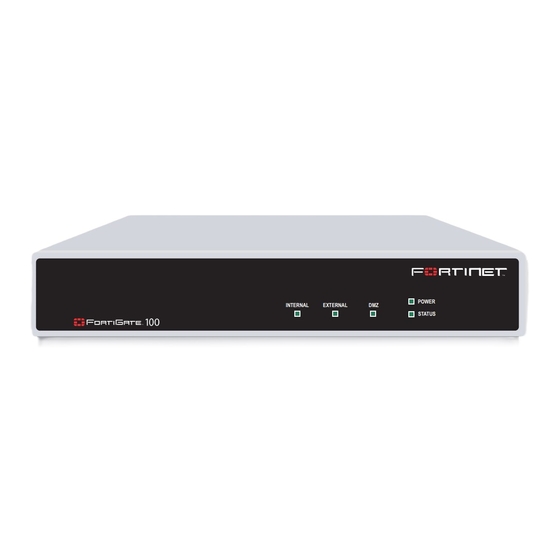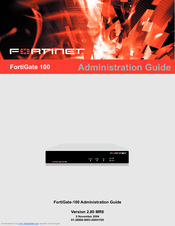
Fortinet FortiGate 100 Manuals
Manuals and User Guides for Fortinet FortiGate 100. We have 3 Fortinet FortiGate 100 manuals available for free PDF download: Administration Manual, Installation & Configuration Manual, Installation Manual
Fortinet FortiGate 100 Administration Manual (388 pages)
Fortinet FortiGate FortiGate-100: User Guide
Table of Contents
-
Introduction
13 -
-
Status26
-
Session List31
-
-
-
Interface47
-
Zone57
-
Management59
-
Dns60
-
-
System DHCP
73 -
-
System Time81
-
Options82
-
Snmp97
-
Fortigate Mibs101
-
Fortigate Traps102
-
Fortimanager108
-
-
-
Administrators109
-
Access Profiles111
-
-
-
Virtual Domains134
-
Router
141-
Static141
-
Policy145
-
Rip146
-
General147
-
Networks List148
-
Networks Options149
-
Interface List149
-
Distribute List151
-
Offset List153
-
-
Router Objects154
-
Access List154
-
New Access List154
-
Prefix List155
-
New Prefix List156
-
Route-Map List157
-
New Route-Map158
-
Key Chain List160
-
New Key Chain160
-
-
Monitor162
-
-
-
Config Network179
-
-
-
Firewall
189-
Policy190
-
Address198
-
Address List199
-
Address Options199
-
-
Service202
-
Schedule210
-
Virtual IP214
-
Virtual IP List215
-
-
IP Pool218
-
-
-
Local234
-
Local User List234
-
-
Radius235
-
Ldap236
-
LDAP Server List237
-
-
User Group239
-
User Group List239
-
-
Vpn
245-
Phase 1246
-
Phase 1 List246
-
-
Phase 2250
-
Manual Key253
-
Manual Key List254
-
-
Concentrator255
-
Ping Generator256
-
Monitor257
-
Pptp259
-
L2Tp263
-
Certificates268
-
-
Ipsec Phase1273
-
Ipsec Phase2275
-
Ipsec Vip276
-
-
Dialup VPN279
-
Dynamic DNS VPN279
-
-
Special Rules283
-
-
Troubleshooting290
-
-
Ips
291 -
Antivirus
303-
File Block304
-
Quarantine306
-
Config310
-
Virus List310
-
Grayware311
-
Grayware Options311
-
-
-
Heuristic312
-
Quarantine313
-
Service Http314
-
Service Ftp315
-
Service Pop3316
-
Service Imap317
-
Service Smtp318
-
-
-
Web Filter
321-
Content Block322
-
URL Block324
-
URL Exempt327
-
Category Block329
-
Script Filter333
-
-
Spam Filter
335-
IP Address338
-
Rbl & Ordbl339
-
Email Address341
-
MIME Headers342
-
Banned Word344
-
Log & Report
349-
Log Config350
-
Syslog Settings353
-
-
Traffic Log356
-
Event Log356
-
-
Log Access359
-
-
Fortilog Setting362
-
Syslogd Setting363
-
-
-
Glossary
377 -
Index
381
Advertisement
Fortinet FortiGate 100 Installation & Configuration Manual (272 pages)
Fortinet Network Device Installation and Configuration Guide
Table of Contents
-
Introduction
13-
Firewall15
-
Vpn16
-
-
Firewall20
-
Vpn20
-
Nids21
-
Antivirus21
-
Web Filter21
-
Email Filter21
-
-
Mounting28
-
Powering on29
-
Next Steps41
-
-
-
-
Session List89
-
-
-
-
-
-
Configuring SNMP134
-
-
-
Addresses142
-
Services143
-
Schedules143
-
Content Profiles143
-
-
Addresses150
-
Services153
-
Schedules157
-
Virtual Ips160
-
IP Pools164
-
IP/MAC Binding166
-
Content Profiles169
-
-
-
Ipsec VPN
181-
Key Management182
-
-
-
Configuring PPTP207
-
Configuring L2TP213
-
-
-
Logging Attacks228
-
-
File Blocking233
-
Web Filtering
235-
Content Blocking236
-
URL Blocking237
-
Script Filtering242
-
Exempt URL List243
-
Email Filter
245 -
-
Recording Logs249
-
-
Viewing Logs255
-
Searching Logs256
-
-
-
Glossary
259 -
Index
263
Fortinet FortiGate 100 Installation Manual (54 pages)
Fortinet FortiGate FortiGate-100: Install Guide
Table of Contents
-
-
Mounting12
-
Next Steps23
-
-
Next Steps34
-
-
Index
53
Advertisement


